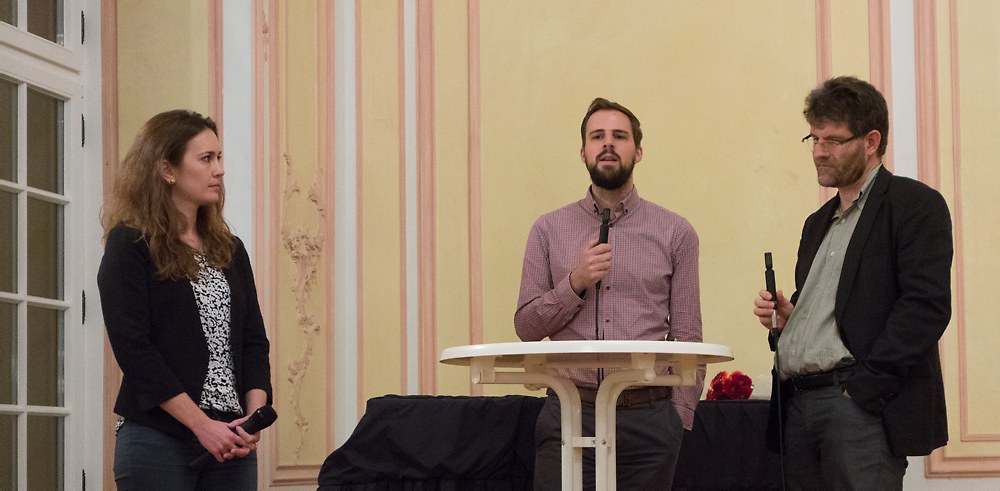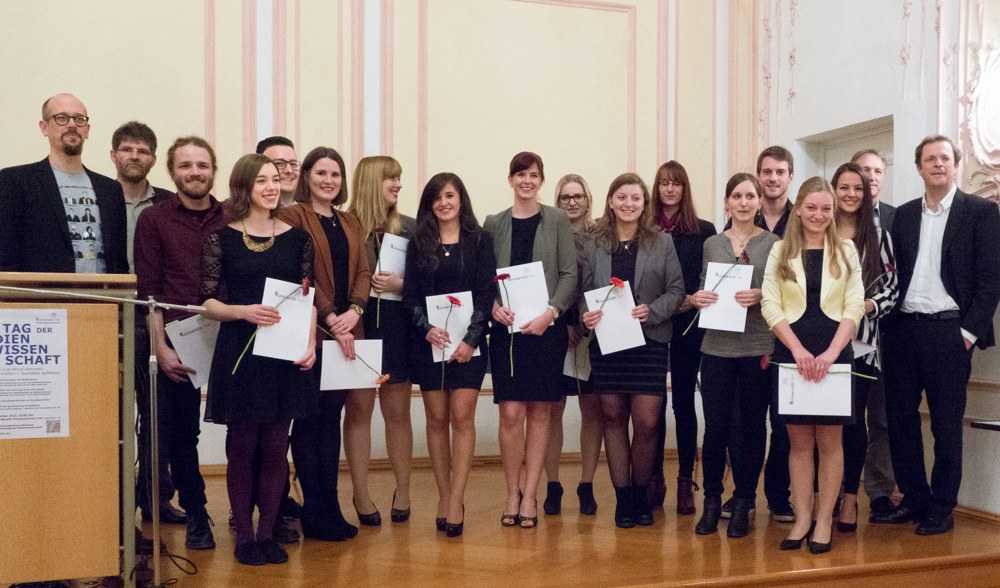Stephan Schwingeler at the day of media studies Computer games as media art
“Computer games as media art”: In this year, we invited Stephan Schwingeler, a pioneer in the field of game studies and himself alumni of media studies in Trier, to give a keynote at the day of media studies. Taking a media studies perspective, he talked about an area which we consider not often enough. How are computer games used in media art?
Stephan Schwingeler: “Computer games as media art”
Stephan Schwingeler explained that there are three approaches of academic study of computer games:
- In the beginning, computer games were approached from the perspective of film and literature studies, considering them as texts.
- In a reaction to this view, the critical game studies developed later, which focused on the playful aspects of games.
- In the tradition of visual culture, games are explored as images, inviting us to immerse into new worlds. In this regard, Stephan Schwingeler talked about a “spatial turn” in game studies, considering games as navigable spaces.
Art history of computer games

After these introductory remarks, Stephan Schwingeler drew a short media history of computer games as art. “ArsDoom” (1995) is considered the first game to be shown in the context of the art festival Ars Electronica. Peter Weibel, today working at the ZKM in Karlsruhe, instructed the artist Orhan Kipcak with a concept in the form of a game – this resulted in a modification based on the shooting classic “Doom II”. Players navigate through a virtual model of the Bruckner building in Linz, and are confronted with giant heads of several artists. The weapons of the original turned into artistic artefacts like the well-known Cross of Joseph Beuys, allowing to defeat the monster heads. Stephan Schwingeler considered “ArsDoom” a “satire”, which acts like the “revenge of the medium computer games against the cultural activities”.
After “ArsDoom”, computer games became established as a medium of art. Stephan Schwingeler sees a new generation of artists, having grown up with computer games, as the reason for this move. Furthermore, it was important that artists had access to computer games as material.
Little history of computer games
The history of the computer game is itself closely related to the history of computers: “Humans started playing with computers as soon as they had access to them.” As early as 1958, William Higinbitham developed “Tennis for Two”, arguably the first video game of all times. It was based on an oscilloscope, originally meant to show voltage – a classical hack, using technology for new means. “Spacewar!” on the early computer PDP-1 followed in 1962, developed by Steve Russell. The game has been groundbreaking, not only for their character as a pioneer, but also in another respect: The source code was freely available, so that it was possible to copy or change it at any time.
The formerly oppositional computer games became an institution themselves in the 1970s. Since the late 90s only, artists are using methods of appropriation and rededidaction against them.
Claus Pias, Zukünfte der Computer (translation by myself)
In the 1970s, the computer game grew into a veritable mass market – source code became a secret, locked into automats and modules. This restrictive approach to source code made the work of media art harder. However, a little bit later, communities developed which modified games, often in terms of fan projects. The closed character of computer games was picked up by artists like Cory Arcangel and his “Super Mario Clouds", when he disassembled and modified the game modules. This only leaves the characteristic clouds of the game classic "Super Mario" in "Super Mario Clouds" – however, this is not a film, but still rendered live by the game.
Artistic strategies while working with computer games
How do artists use computer games as material of media art? Stephan Schwingeler identified four strategies to answer this question:
- New ornamentation: Games are modified in an artistic way. The aforementioned “ArsDoom” is an example of this approach, or Hunter Jonakin´s “Jeff Koons Must Die!”, for which the artists constructed his own arcade automat. The task of the player is destroying the pieces of art by Jeff Koons.
- Reduction and abstraction: Games are reduced to their basic parts. Examples for this approach are the aforementioned “Super Mario Clouds” or “Mario Battle No. 1” by Myfanwy Ashmore. This games uses the game mechanics of “Super Mario Bros.”, but in a new context: All enemies, items, and traps have been removed, rendering the game experience completely different.
- Action and performance: This strategy builds on games as actions. The focus of the artist is the idea that players act in games. These actions are used in order to create pieces of art. In “dead-in-iraq”, a performance by Joseph DeLappe, the artist uses “America’s Army”. The game was developed by the US military in order to recruit soldiers. However, DeLappe uses it for his art, throwing his weapon away in the virtual battles and posting the names of soldiers killed in action in the chat.
- Destruction: The final strategy creates unplayable games. In “SOD” by JODI, the game mechanics of “Wolfenstein 3D” are changed so drastically that only fractions of the game are left. The screen is white, apart from geometric black objects, but the player can still navigate through this three-dimensional space. Fragments of the game rest available, like sounds or the weapon in the form of a single point. However, the player cannot really interact with the world in any reasonable way. The artists thus remind of other art works like Robert Rauschenberg's “White Paintings” or Nam June Paik's “Zen for Film”.
Media theory: art with computer games between transparency and opacity
Finally, Stephan Schwingeler talked about some media theoretical ideas concerning computer games. Normally, the function of the medium is being invisible, as the players should immerse themselves into the game world, concentrating entirely on the content. Stephan Schwingeler referred to this approach as transparency: The medium itself becomes invisible. However, there are always moments where the game meets the limits, becoming visible again (opacity).
Art often plays with these differences. In the 256th level of Pacman, the characters of the game can get entangled in the source code. The software is based on 8 bits, meaning there are 256 possible levels. It is important to know that counting in bits always begins with 0, so there are values from 0 to 255. Normally, the game was supposed to be infinite in the way that as long as the player still has a life left, there should always be a new level provided. In case a player managed to beat the final level, the game should use the first level again. But a bug in the source code caused the level counter to jump to 256, causing a buffer overflow and executing code which does not make sense. The right half of the screen ist filled with letters, while in the left half, there are not enough points to be gained to beat the level. Players who got that far realize that Pacman is a game without a solution.
Media scholars talk about their jobs
Besides this inspiring brain juice on computer games as media art, there was also applicable advice for entering into a job. We had Lisa Keimburg of the Media Authorities and Julian Ermert of the agency zebralog (Bonn) on the stage, both alumni of media studies in Trier.
Protection of minors and civic participation
Lisa Keimburg is working as consultant for the protection of minors and public relations. She drew a picture of her daily business on the job, where she is not only writing texts or maintaining the web site, but also in charge of a huge part of project management. This is about concluding contracts and checking the results, organizing events, and planning fairs.
Julian Ermert explained what the work is like in a research oriented agency. Zebralog is concentrating on crossmedial projects of civic participation. His activities are the concept, editing and communication of all topics related to civic participation. Project management also plays a vital role in this work.

Most wanted: project management
Thus, project management is one of the topics not covered enough in studies, as both speakers agree. “There was a lot which I had to learn from the ground up”, Julian Ermert explained. But project management is difficult to teach outside of practical work, due to the lack of context. However, both speakers said they acquired a lot of relevant abilities during studies. Lisa Keimburg stressed that she learned to work on her own at university. Additionally, the basic knowledge about the German media system, the relationship of media and politics, and media theories proved their value. She also mentioned her experiences in the reception lab, because it is good to know how humans understand content. Julian Ermert endorsed this, explaining that it is important to do research in unknown topics. “A while ago I had to investigate in a very short time which types of disposals exist. This means wading through giant documents”, he explained. He stressed structural thinking like the question how stakeholders interact. His task is making complicated things easy to understand.
How to transition into a job
A striking similarity of both speakers was the fluent transition into working life. Lisa Keimburg finished her magister thesis when she already had her trainee position. Julian Ermert told that he started working for zebralog during his master thesis. However, Lisa Keimberg also stressed that it is not unusual to need a bit of time to find the right job after studies. She encouraged alumni: “I observed that with a lot of my friends, but all of them managed to find good job.” It is also important to consider the long time periods that candidatures can take, making it reasonable to start applying during the phase of examination.
Naturally, the job life is a noticeable change. “During studies, there is a lot of flexibility, but structures of offices are more rigid”, Lisa Keimburg told. “I created a structure with fixed working hours for myself during the process of my magister thesis – but I can image this to be harder for people liking to work at nights.”
Julian Ermert said that for him, the biggest change was to be more precise. “Often, you only have a couple of days for a concept, before a colleague needs to take over. This means you have to get to the point.” Effective work and a selective view of the essential is important.
Is the master degree worth it?
Should one stay with a bachelor, or continue doing a master? Julian Ermert observed that the master is the rule, but not a necessity. The second studies typically loom more in the work life and offer the opportunity to specialize. In general, it is important to listen to the inner voices and take the opportunities as they emerge. “To a certain degree, it is always a bit of destiny involved, determining where you land – but you can always influence it in the right direction by focusing on a particular topic”, Julian Ermert explained. It is thus important to grow an expertise in a topic for which there is a market demand. “This does not mean being blinkered – you should try each area, but always return to your market.”
Tribute to the alumni
The yearly tribute to the alumni of Bachelor, Master, or Magister degrees has grown into a nice tradition. It would certainly be too much to give each of the thesis topics the place it deserves – but I was impressed by the range of topics covered.

You can find some impressions from the tribute here: